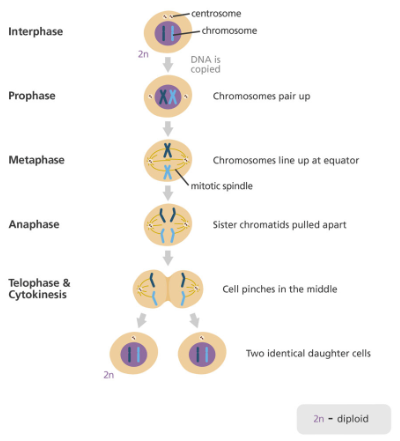Cell Division
Chromosomes
The nucleus of a cell contains chromosomes made of DNA molecules.
Each chromosome carries a large number of genes.
In body cells, the chromosomes are normally found in pairs (23 pairs).
Importance of Mitosis
Mitosis is needed for repair and replacement of cells:
- at site of wound or injury
- during growth spurts
- during production of red blood cells in bone marrow (which happens all the time).
Mitosis takes place rapidly when an egg is newly fertilised, as the egg grows bigger as it develops further.
Stages of Mitosis
During mitosis, cells divide to produce two new ones which are exact copies of the original cell. Two daughter cells are produced from the parent cell. Each daughter cell has 46 chromosomes.
All body cells divide by the process of mitosis, and are therefore identical to their parent cell. The only cells in the human body that do not undergo mitosis are the gametes, or sex cells (egg and sperm) which undergo a different process called meiosis. Egg and sperm cells each only have 23 chromosomes.
- During the cell cycle the genetic material is doubled and then divided into two identical cells.
- Before a cell can divide it needs to grow and__ increase the number of sub-cellular structures__ such as ribosomes and mitochondria. The DNA replicates to form two copies of each chromosome.
- In mitosis one set of chromosomes is pulled to each end of the cell and the nucleus divides.
- Finally the cytoplasm and cell membranes divide to form two identical cells.
__Here are the stages of mitosis in a diagram: __
Stem Cells
A stem cell is an undifferentiated cell of an organism which is capable of giving rise to many more cells of the same type, and from which certain other cells can arise from differentiation. Stem cells can be found in both animals and plants.
When a fertilised egg develops, it becomes an embryo. When the embryo is still in the early stages of development, they are considered stem cells. This means that__ the cells had the potential to specialise into different types of cells__.
This is extremely important as multi-cellular organisms require lots of specialised cells to work together in order to function.
A limited number of adult stem cells can also be found in adults, but they are limited in the following places:
- nose
- eyes
- brain
- blood
- heart
- skin
- bone marrow
- muscle.
Adult stem cells are slightly different to__ embryonic stem cells__, as adult stem cells can only differentiate and specialise into related cell types.
Scientists are extremely interested in the study of stem cells, as they have the potential to become anything. This may suggest that damaged cells can be repaired and that they will potentially regrow. This scientific research could benefit millions of people. Lots of research are currently being conducted, especially on animals.
Scientists are slowly trying to use stem cells to create specialised cells that can repair certain organs like eyes and lungs.
There is a possibility that new organs can be created by stem cells.
Treatment with stem cells may be able to help conditions such as diabetes and paralysis.
Stem cells can also be found in specific regions of plants. Meristems exist in plants as it ensures that plants have the capacity to grow taller and wider throughout its life.
It is possible to clone plants from the stem cells that can be found in the meristem regions.
Therapeutic Cloning
In therapeutic cloning an embryo is produced with the same genes as the patient.
Stem cells from the embryo are__ not rejected__ by the patient’s body so they may be used for medical treatment.
The use of stem cells has potential risks such as transfer of viral infection, and some people have ethical or religious objections.
Cloning of plants also has uses:
- Stem cells from meristems in plants can be used to produce clones of plants quickly and economically.
- Rare species can be cloned to protect from extinction.
- Crop plants with special features such as disease resistance can be cloned to produce large numbers of identical plants for farmers
- Which type of stem cell in can differentiate into any type of cell (in animals)?
- Embryonic
Explanation: Adult stem cells can only differentiate into related types of cell - How many pairs of chromosomes are there in body cells?
- Your answer should include: 23 / 23 pairs
- How many chromosomes does the egg have?
- Your answer should include: 23 / 23 chromosomes
Explanation: Gametes (egg and sperm cells) only have one copy of each chromosome
